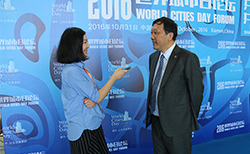


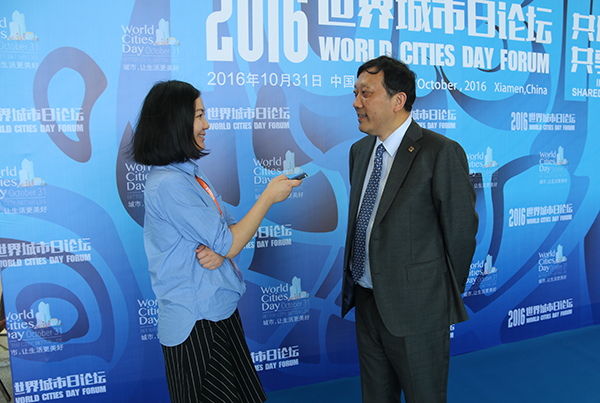
UPSC reporter: This year, we celebrate the third World Cities Day on Oct 31. Coincidental the New Urban Agenda has just been adopted by the United Nations Conference on Housing and Sustainable Urban Development (Habitat III)。 As an invited expert, can you tell us what specifically China has done in the preparation process?
SHI Nan: Ten days ago, New Urban Agenda(NUA) was adopted by all the countries and regions at Habitat III, which is a major political promise made by countries within the UN-system to tackle challenges of global urbanization. New Urban Agenda itself contains a recommended new model of urban governance of UN. In this strategic agenda, China has contributed ,in particular, the recent 30 years experience of urban success and lessons after China’s Open and Reform Policy.
The NUA is a general consensus by all the urban managers, planners and stakeholders around the world, after accumulated efforts of 4 major modifications and numerous checking and revisions.
How did China take part in New Urban Agenda’s drafting?
It all started from November 2013 when UN decided to compose a technical paper, International Guidelines on Urban and Territorial Planning(IGUTP)。 Two experts in China were called upon for this mission, me representing UPSC and Professor WANG Hongyang from Nanjing University as an expert from International Society of City and Regional Planners(ISOCARP)。 I and professor Wang followed the whole process of the drafting of the International Guidelines, including 3 round face-face meeting and all these discussions, corresponding and research, together with 23 experts from all around the world. This document was finally approved by UN-Habitat governing council by April 2015 as a prep-product of Habitat III.

2014 SHI Nan in Japan preparation meeting of IG-UTP
New Urban Agenda basically follows the general idea and framework of International Guidelines on Urban and Territorial Planning(IGUTP)。 As all countries are faced with the common challenges such as climate change, economic crisis, unsustainable development and rapid urbanization. Especially for developing and under-developed countries, rapid urbanization is the major story, rendering these countries also vulnerable to climate change impacts. Twenty years after the Habitat II in Istanbul, with urbanization as the most urgent transformative trend in the world, UN has brought us together to come up with some solutions for the complex challenges.To differentiate from previous two HABITAT conferences, integrated urban planning is in the core of the New Urban Agenda. The Habitat II called for Cities and Homes for All, while Habitat III 2016 sets its goal for cities for all. In this context, it offered a unique opportunity to discuss the important challenge of how cities, towns, and villages are planned and managed in order to fulfill their role as drivers of sustainable development and, hence, shape the implementation of new global development and climate change goals.
UN Values China’s urbanization experience
China’s urbanization coincides with global urbanization at about 55% for the present. China’s urbanization rate increased from 30.5% in 1996 to 56.1% in 2015, at an annual growth rate of about 1.3%, which is also approximately the same with global urbanization growth rate. The reasons why UN values China’s urbanization experience lie in two aspects, on one hand, China steps at the same pace with world urbanization, on the other hand, the way Chinese government treats urbanization sets a good example for other countries in UN-system. For the twenty years after Habitat II, Chinese government made it clear to strongly push urbanization with Chinese characteristics as a way of economic growth stimulation, social conflicts remission and sustainable development achievements. Therefore, Habitat III particularly expects China’s story of urbanization in line with its goal to improving living conditions for our common world.
We have all been aware that, China is the largest developing country, contributing to global society in many aspects. For example, China have successfully lifted more than 60 million people out of poverty, and the poverty headcount ratio has dropped from 10.2 percent to less than 4 percent. Poverty lifting is a crucial goal of UN, and poverty lifting in the process of urbanization is also common phenomena. By providing its 1.3 billion people with food and clothing and adequate shelters, China has made huge contributions to global poverty lifting.
It is agreed that China has set up a good example of promoting good urban planning for sustainable urbanization. Chinese government used to emphasize on planning when we the adopted planned economy, after reforming to develop the socialist market economy, urban and regional planning is also greatly weighed upon. In 2014, the Chinese government issued the National Plan for New-type Urbanization(2014-2020), and in 2015, the Chinese government convoked the Central Urban Work Conference, which make all overall arrangement on urban planning, construction and management. Therefore, UN thinks that China’s experience of guiding the urban development with plans so as to advance the sustainable development of cities can be a solution to global complex challenges. UN values China’s urbanization experience
UPSC’s role in the drafting of New Urban Agenda
After the approval of International Guidelines on Urban and Territorial Planning(IGUTP), UN started a long and hard road of 2 years towards New Urban agenda.
During the whole process, many Chinese urban experts participated the China national report and the 25 issue papers which focused on specific areas of human settlements such as housing, public space and land.
After that, Habitat III set out ten policy units to study on 10 policy papers, which identify policy priorities, critical issues, and action-oriented recommendations in relation to the implementation the New Urban Agenda. These policy papers served as official inputs in the Habitat III process and played a key role in the formulation of the zero draft of the New Urban Agenda.
UPSC is summoned to recommend Chinese experienced urban experts to participated in the policy units, and at last, Professor Maoqizhi from Tsinghua University, Dr. He Yong from Beijing Municipal Institute of City Planning& Design, and me took part in three policy units and contributed to the discussions and final outcomes.
UPSC and Italian Institute of Planning co-organized the No.6 Policy Unit, Urban Spatial Strategies: Land Market and Segregation.
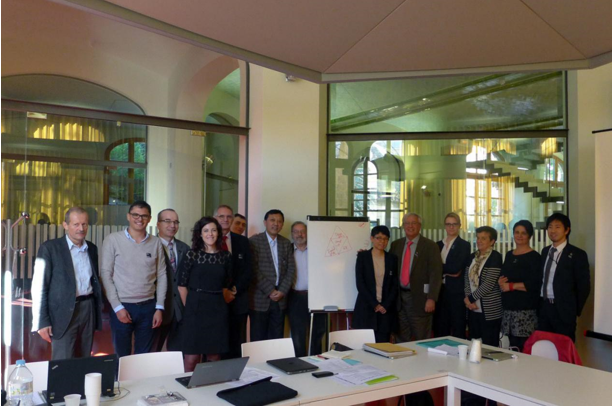
2015.11 the first meeting of policy unit 6
By March 2016, all the policy units had submitted the papers to the secretariat of Habitat III for the zero draft of the New Urban Agenda.On April 25, I represented UPSC participating the first open-ended consultation in UN headquarters in New York.
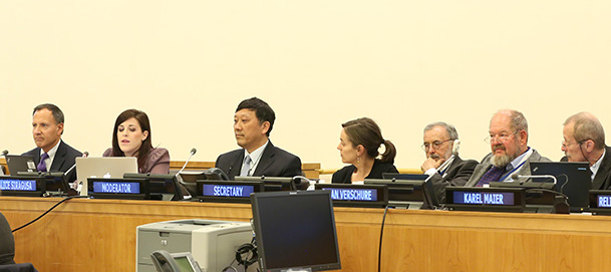
The first open-ended consultation brought together all member states and international organizations including UN-Habitat, UNDP, World Bank, Women, Refugees as well as professionals such as ISOCARP, UPSC and UCLG. On this important meeting, member states are divided into two groups, EU and the U.S. and some developed countries vs. China and 77 developing countries. After 3 days’ hard consultation, UN finally come up with zero draft of New Urban Agenda, which was open to the public on 10 May.
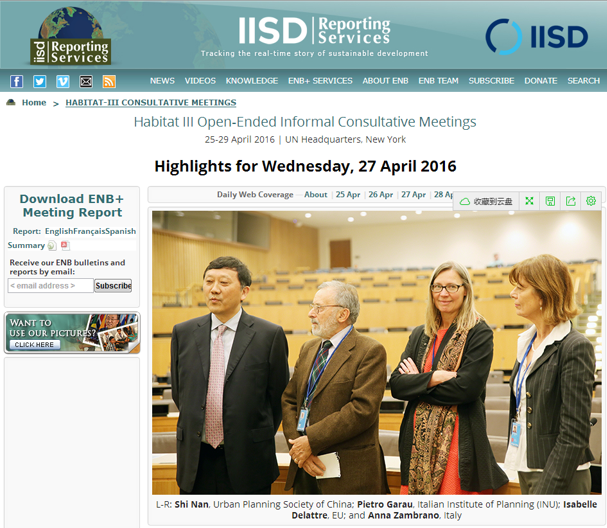
2016.4 UPSC at UN headquarters for the open-ended consultation PrepCom 1
The following intersessional meetings include the second and the third open-ended consultations. Political concerns and national interests were mixed into the technical document.When I participated in the fourth consultation in New York, each member state had to agree on the final draft on the spot. Many delegates had to inform their capital for the decision and modification suggestions, and the meeting lasted for 38 hours non-stop. Finally, we reached the consensus.
Chinese Experience in New Urban Agenda
The New Urban Agenda encapsulates the wisdom and consensus of all member states and stakeholder groups. As the blueprint for the development of future cities, we, the Chinese urban planners who participated in the whole process, believe that it also embodies the vision of innovative, coordinated, green, open and shared development, just as Chinese urbanization itself.
I think the following six aspects of Chinese experience has been successfully integrated into the New Urban Agenda.
First, integrated urban and rural planning is at core place of urbanization. Only by guiding the urbanization with sound plans can we achieve the goal of better cities, better life and sustainable development. Urban Planning and Design is greatly emphasized so as to provide adequate common goods.
Second, providing everyone with adequate housing is the key to inclusive cities and tackling many urban problems. Chinese government has made great efforts to provide its urban migrants with shelters. In particular, the government had provided the aged, women and children and their family members who used to live in shanty areas with more than 26 million units of spacious apartments. 17 million families had acquired access to government-subsidized housing, mainly in the form of public-rental houses. UN realized that human development rights are closely related to human settlement rights. China has worked hard to solve its housing problems.
Third, infrastructure is fundamental to urban development. Chinese government had greatly promoted its urban infrastructure since Reform and Opening up policy was adopted 30 years ago. Recent years, China’s rapid urbanization is greatly supported by urban and regional infrastructure construction not only for cities but also in rural regions. This infrastructure-first policy has been acknowledged by other countries and reflected in New Urban Agenda.
Fourth, Chinese government endeavors to equalize public services in order to ensure everyone’s equal access to public service, public utilities, and public space. No matter his/her political, economic or social status, income, gender, or health situation, the government should offer equal opportunities for all. The New Urban Agenda ensures everyone is on board, which is exactly the same as what China is doing right now
Fifth, intervene to prevent land market failures has been and still be an issue for China. For the past a dozen years, by auctioning the urban building land tenure, Chinese local governments successfully improved the finance capacity of the public sector to guide urban development, especially when it comes to the provision of urban infrastructure and services. How to avoid private sector’ s speculation? How to avoid urban sprawl in disorder? How to encourage mixed-income development with equal access to land value increment accruing from public investment? These questions remain to be answered.
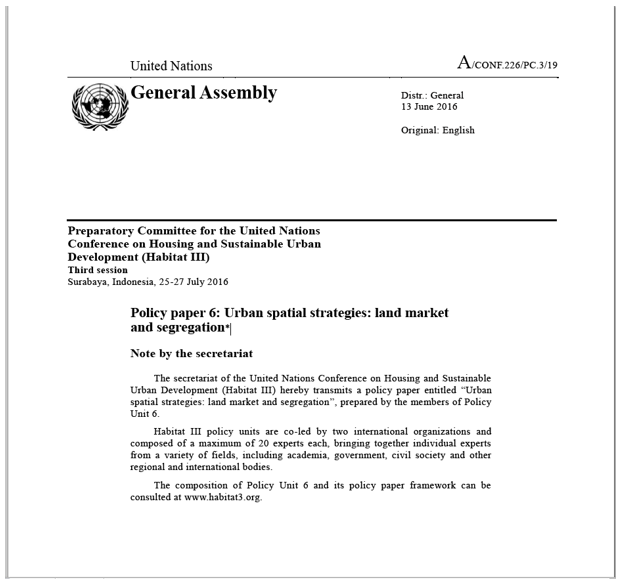
Policy paper 6: Urban spatial strategies: land market and segregation*
(organized by UPSC and INU)
Sixth, for cultural relics conservation. China has set a good example for other developing countries with its laws, regulations and plans on conserving historical and cultural cities, villages and towns. Indeed, China is facing many problems of losing its precious relics, we are open to discussion and ready to pay attention to it. The Chinese government has realized that urban culture is an important part of sustainable development, and urban culture is indispensable of urbanization in social aspect.
In all, many Chinese experience has been integrated into New Urban Agenda. It is our humble contribution as the biggest developing country to UN family.
China Is Learning, Sharing, and Ready to take responsibilities
For Habitat III, I am very happy that UN values Chinese experience and integrated our story into New Urban Agenda for sharing. I believe and I have said on many occasions, that China is learning, and also sharing for present world. To share our experience is to take our responsibilities in global society, and to tackle the common challenges with other countries together. We learn, we share and we take our responsibilities as a big country now.